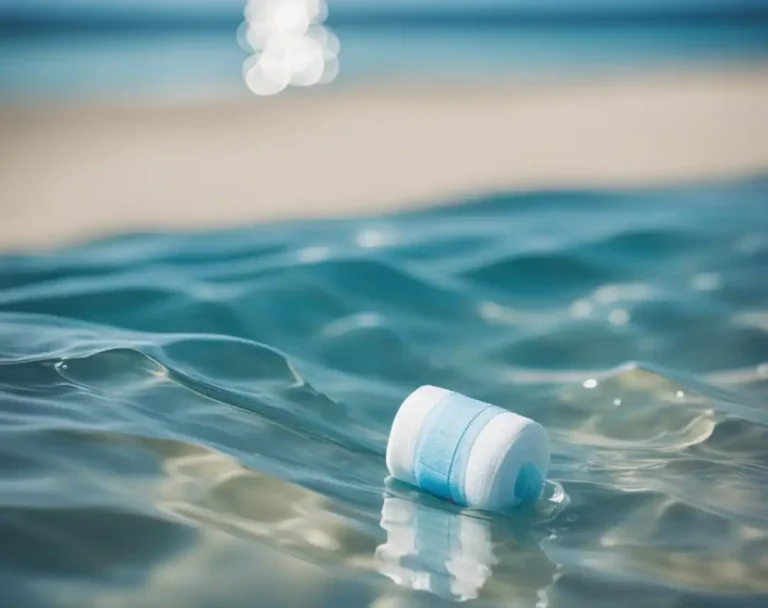Imagine diving into the cool embrace of a pool, only to emerge with a stinging sensation in your ears. That’s right, we’re talking about that all-too-familiar ear pain after swimming. It’s like the water whispers a lingering, uncomfortable secret, one that resonates deep within your ear canal, turning your serene swim into a nagging ordeal.

Why does this happen? When you’re gliding through the water, feeling weightless and free, the last thing you expect is for pain to gatecrash your aquatic escapade. Yet, here it is, a stark reminder that our bodies sometimes react in ways we wish they wouldn’t. This ear pain isn’t just a mere annoyance; it’s a signal, a call to pay closer attention to what our bodies experience in different environments.
The discomfort can be a dampener, yes. But it’s also an opportunity to learn and adapt. It nudges us towards finding solutions, towards ensuring our swimming adventures remain joyful and pain-free. So, let’s dive deeper into understanding why this happens and how we can keep our ears happy, ensuring that the only thing we take back from our swims is the joy of the splash and not the echo of pain.
Understanding Ear Pain After Swimming
Ever plunged into the pool and emerged with an earache? That’s a sign your ears are throwing up red flags! Discovering the why and how of post-swim ear pain can help you dive back in, worry-free.
Causes of Ear Pain Post-Swimming

When I hit the water, sometimes my ear canals aren’t too thrilled, and it’s no surprise—water trapped in my ears can be a party for bacteria or even fungus, leading to infections. Swimmer’s ear gets its name from just such scenarios. Here’s what to look out for:
- Persistent ear pain
- Itchy ears, especially in the outer ear canal
- Redness and swelling
Nota bene: If your earache arrives after swimming, it’s often due to water that’s overstayed its welcome. Take heed—clean water or not, bacteria love a damp ear canal!
Identifying Swimmer’s Ear and Other Infections
Swimmer’s ear, clinically known as otitis externa, targets my outer ear canal, the tunnel that leads to my eardrum. It’s the hallmark of swimming-gone-awry ear issues. Identifying it might save me another trip to the doctor:
| Symptom | Swimmer’s Ear | Other Infections |
|---|---|---|
| Ear Pain | Often severe | Variable |
| Discharge | Possible | Less common |
| Hearing Reduction | Sometimes | Occasionally |
Got ear pain after swimming? It could be swimmer’s ear. A visit to my healthcare provider can get me sorted out, primed, and ready for my next aquatic adventure!
Recognizing Symptoms and Signs
When I first faced ear pain after a refreshing swim, I was clueless about what I was dealing with. To my surprise, I discovered that it’s essential to know the pesky symptoms of swimmer’s ear and the telling signs of ear infections that can affect both children and adults. So, let’s dive into the specifics!
Symptoms of Swimmer’s Ear
Swimmer’s ear can really catch you off guard with itching in the ear canal, which often spirals into more alarming discomfort. Picture this: you experience pain, especially when you touch or wiggle your earlobe; it’s like a red flag waving at you. Don’t ignore it! What starts as a mere nuisance can quickly turn into a sensation of your ear being blocked or fullness accompanied by reduced hearing—as if you’re underwater even when you’re not.
Signs of Ear Infections in Children and Adults
Spotting an ear infection involves being a bit of a detective. Children might tug at their ears in distress, looking rather tender in the affected area. The clues? Redness and swelling are telltale, but pus or discharge leaking from the ear is a direct giveaway that an infection is crashing the party. In adults, these signs persist and can be just as evident. So, keep your eyes peeled; it’s about being proactive to ensure everyone’s ears stay happy and healthy!
Diagnosis and Professional Care
The moment I felt a pang of ear pain after a refreshing swim, I knew prompt action was essential. Ear issues can dampen the joy of swimming, but understanding when to seek medical attention and what diagnostic procedures to expect clarifies the path to relief.
When to See a Doctor
If my ear pain persists beyond a few hours or is accompanied by hearing loss, discharge, or fever, I don’t hesitate to visit a doctor. Furthermore, if the pain is severe or if I’ve had recent head injuries, it’s crucial to get professional care.
Diagnostic Procedures
A doctor will typically use an otoscope, a tool designed to provide a clear view of my ear canal and eardrum. This painless procedure will help determine if there’s an infection or other issue. Sometimes, a doctor may also perform a hearing test to assess if the ear pain has impacted my hearing. Below is a list of what a doctor might look for during my examination:
- Signs of infection
- Blockages in the ear canal
- Eardrum damage
- Fluid buildup
By seeing a doctor and undergoing these procedures, I can get an accurate diagnosis and the right treatment to get back in the pool pain-free.
Effective Treatments and Medications
I’ve often found that the sting of ear pain after a great swim can quickly dampen the day’s joy. But fear not! You can turn to reliable treatments and medications that work wonders in soothing that pesky discomfort. Now, let me guide you through some of the most effective strategies to combat this issue.
Using Ear Drops and Medications
- Ear Drops: These are my first line of defense when it comes to treating ear pain post-swim. Over-the-counter (OTC) eardrops often contain a combination of alcohol and acetic acid, which not only helps dry out excess water in the ear canal but also prevents the growth of bacteria. To apply, simply tilt your head and put the instructed number of drops into the ear, then hold for a few seconds before letting it drain out.
- Pain Medicine: If the ear pain is disruptive, I turn to OTC pain relievers such as ibuprofen or acetaminophen. These can help reduce inflammation and manage pain effectively.
- Antibiotics: In cases where an infection is suspected, a doctor may prescribe antibiotic ear drops. They contain medication that targets bacteria directly in the ear and can greatly shorten the duration of pain and discomfort.
Advanced Treatments for Severe Cases
For those unlucky times when the ear pain indicates more severe complications, consulting a healthcare professional is a must. If standard treatments don’t provide relief, or if symptoms persist, it could be a sign of a more serious problem, like an ear infection or swimmer’s ear.
- Prescription Medication: Severe pain or infection may require prescription-strength pain medicine or antibiotics designed to tackle more resilient bacteria.
- Follow-Up Care: It’s vital to adhere to the prescribed course of treatment and attend any follow-up appointments to ensure the problem is resolved completely.
Remember, taking proactive steps can help prevent ear pain and complications from getting in the way of your love for swimming.
Home Remedies and Immediate Actions
I know how troubling ear pain after a swim can be! If you’re like me, seeking immediate comfort is a top priority. Let’s explore some quick and safe home treatments that could soothe that discomfort and get us back to feeling great.
Safe Home Treatments
Warm Compress: I’ve found it extremely helpful to use a warm compress to ease ear pain. You can dampen a clean cloth with warm water, wring it out, and hold it against your ear for a few minutes. Remember, it should be warm, not hot, to avoid any skin irritation.
Hair Dryer: Using a hair dryer can also be effective. I like to set it on the lowest heat and fan setting, holding it a good distance from my ear, allowing a gentle flow of warm air to reach inside. This can help evaporate any trapped water and alleviate itchiness.
Tips for Symptom Relief
Over-the-Counter Pain Medicine: Taking OTC pain relief, such as ibuprofen or acetaminophen, as per dosage instructions, can reduce ear pain significantly. I make sure to read the label carefully and never exceed the recommended dose.
Avoid Cotton Swabs: I avoid inserting anything like cotton swabs into the ear canal, as tempting as it might be. This can push earwax deeper and might even cause more pain or hearing loss.
Towel-Drying: After swimming, I always make a point to dry my ears gently with a soft towel. This can help prevent any additional water from entering the ear canal, which could exacerbate the pain.
Using these simple and direct actions, I manage to relieve my ear pain effectively, avoiding complications and getting back to enjoying my day!
Prevention and Protection Strategies
I’m thrilled to share that ear pain after swimming can often be prevented! By understanding how to care for my ears and taking a few simple measures before and during a swim, I’ve found that I can keep my ears healthy and pain-free.
Ear Care and Cleaning
Consistency is my secret weapon when it comes to ear care. I always make sure to thoroughly dry my ears with a towel after swimming or showering, focusing on wicking away all moisture that can harbor bacteria. Sometimes, I use a hair dryer on a low setting to gently air out any trapped water. Plus, I manage my ear wax carefully because a healthy amount of wax actually provides a protective barrier against infection.
- Regularly clean outer ear with a damp cloth
- Avoid inserting cotton swabs deep into the ear canal
Preventive Measures While Swimming
When I dive into the water, I’m already taking steps to protect my ears. Wearing earplugs is a game-changer to block out water, and pairing them with a snug-fitting swimming cap ensures additional prevention against water entry. Plus, it’s not just the swim; I take a quick shower before entering the pool to minimize the exposure to potentially harmful agents in the water.
- Wear earplugs suited for swimmers
- Use a swimming hat to cover ears
By incorporating these strategies into my routine, I help safeguard my ears and can continue enjoying swimming without the worry of ear pain afterward.
Remove water from ear after swimming

If you’re dealing with ear discomfort after swimming, two straightforward methods can help. First, try lying on your side. This simple act uses gravity to gently guide the water out of your ear canal. For a quicker solution, jump on one leg with your head tilted to the side. This playful action helps dislodge the water, bringing instant relief. Both methods are easy and effective, ensuring your post-swim experience remains as enjoyable as the dive itself.

Related Ear Conditions and Complications
When I take a refreshing swim, I sometimes end up with ear pain, which can be a sign pointing towards various ear conditions and complications that I need to be aware of. It’s not just about the water being trapped; it’s the potential for chronic conditions or the risks they pose that grabs my attention.
Chronic Ear Conditions
- Chronic Otitis Externa: Common for swimmers, this is an inflammation of the ear canal. It’s a persistent malady that can be aggravated by swimming, especially if I have an underlying skin condition like eczema or psoriasis.
- Skin Conditions Affecting the Ear: Those among us with eczema or psoriasis might notice their symptoms worsen after dips in the pool due to moisture and chlorine, which can irritate sensitive skin.
Possible Complications and Risks

- Bone and Cartilage Damage: Frequent ear infections can spread beyond just the ear canal, affecting the bone and cartilage. It’s terrifying but knowing this helps me stay vigilant.
- Fungal and Bacterial Infections: Post-swim ear pain isn’t to be taken lightly; a fungal or bacterial infection might be brewing. If I have diabetes, I know I’m at a higher risk and need to take extra precautions.
- Cellulitis and Middle Ear Infections: The skin around my ear could become infected, leading to cellulitis, or the infection can travel to the middle ear, causing significant pain and potential hearing issues.
Lifestyle and Environmental Factors
When I take the plunge into a pool or get caught in a downpour, I’m often struck by how lifestyle choices and our environment play vital roles in the health of our ears. Bearing in mind the delicate balance within our auditory system, it’s clear that routine actions can significantly impact our hearing comfort.
Impact of Daily Activities
Swimming is one of my ultimate joys, but it’s not without risks. The feeling of water trapped in my ears has often led to discomfort, and occasionally, ear pain. Using earplugs is a game-changer to prevent water from entering my ear canals, along with being mindful not to insert fingers or cotton swabs into my ears, which can push the ear wax deeper and cause blockages or infection.
Avoid:
- Inserting objects such as fingers and cotton swabs
- Rough towel-drying which might irritate the skin
Utilize:
- Earplugs while swimming
- Gentle pat-drying after swimming or showering
Environmental Causes of Ear Issues
My adventures outdoors have taught me that environmental elements like rain or water sports can introduce bacteria into the ear canal, leading to pain and infection. People who wear hearing aids must be especially cautious, as moisture and wax buildup can impair device function. I’ve also become aware of other external factors such as hair dye or spray which can irritate the skin, disrupt the natural wax production, and compromise the health of my inner ear.
Be aware of:
- The potential irritants in hair products
- The increased risk of infection in humid or wet environments
Actions to take:
- Cover your ears during hair treatments
- Ensure hearing aids are kept dry and clean
FAQ
Why does my ear hurt after swimming?
Water trapped in your ear canal can lead to infections, causing pain. It’s your body’s cry for help!
How can I prevent ear pain after swimming?
Wear earplugs or a swim cap to keep water out. A simple step for endless pool joy!
What should I do if my ear pain persists?
Don’t ignore it! Visit a doctor to avoid worsening conditions. Your ears deserve the best care.
Thanks for diving into our tips on navigating ear pain after swimming with us! Your experiences enrich our community, so please, share your thoughts and remedies in the comments below. Let’s keep the waters of conversation flowing!






